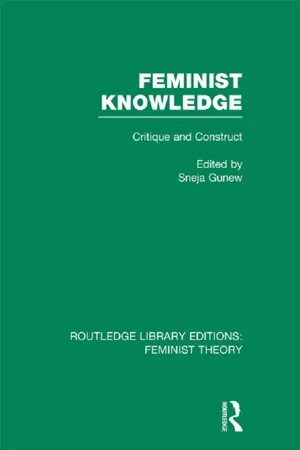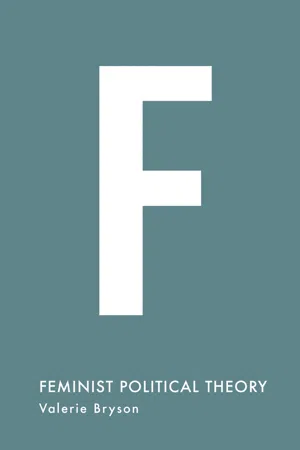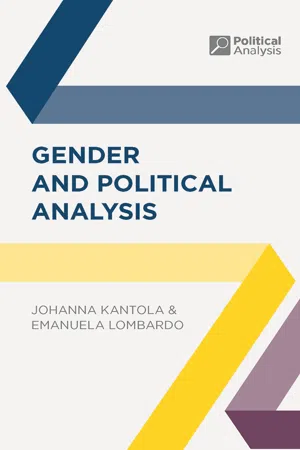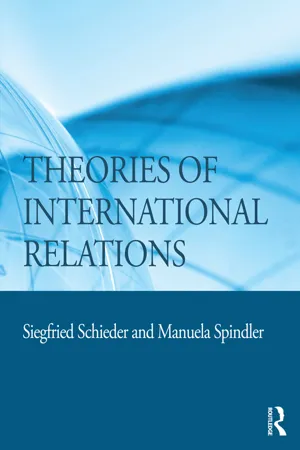Politics & International Relations
Radical Feminism
Radical feminism is a feminist perspective that seeks to dismantle the patriarchal system by addressing the root causes of gender inequality. It emphasizes the need for fundamental societal change and challenges traditional gender roles and power structures. Radical feminists advocate for women's liberation through various means, including political activism and consciousness-raising efforts.
Written by Perlego with AI-assistance
Related key terms
Related key terms
1 of 4
Related key terms
1 of 3
11 Key excerpts on "Radical Feminism"
- eBook - ePub
- Mykola Kapitonenko(Author)
- 2022(Publication Date)
- Routledge(Publisher)
Agenda of feminist theories in IR is extremely broad. It extends from issues of political economy, global inequality and security to grass-root level of family violence, human trafficking or prostitution.Theoretical claims of feminism grew out from various social movements which were fighting discrimination of women. Dramatic events in the end of 1980s gave a chance to challenge both a domination of masculine approaches in IR and the focus of the discipline on wars. A crisis of mainstream theories at the end of the Cold War gave rise to numerous alternatives, shifting emphasis away from constellations of power and hard security towards ideas, norms, perceptions and social interactions. In that regard feminism has much in common with constructivism and critical theories.Feminist theories have multiple issues in focus, and there are plenty of them addressing different aspect of international relations. Standpoint feminism claims that a better perspective can be obtained if views and interests of those oppressed are taken into account. Not only women are those who can be oppressed. Plural standpoint feminism also refers to other social groups. But the general idea is the same: experience of being oppressed should be taken into account and could be a basis of transformation existing social practices and institutions. In international politics, where there is so many various oppressed, that could significantly widen the focus of theoretical knowledge. Liberal feminism, probably the pioneering branch, aims at establishing equal rights for men and women and put an end to discrimination. Radical Feminism offers an agenda that would not just put women on equal terms with men within a framework shaped by masculine attitudes; but counter that masculine framework with feminine values and roles. Marxist interpretation of feminism involves class struggle and issues of labor, as well as separation of public and private spheres. From this perspective, women has become subordinated to men, since capitalist development prioritized public sphere of production over private sphere of household; while social roles of males and females have been predefined in a way, which installed male dominance in a public sphere. - eBook - ePub
Theories of International Relations
Contending Approaches to World Politics
- Stephanie Lawson(Author)
- 2015(Publication Date)
- Polity(Publisher)
But this was also the period in which ‘Radical Feminism’ became distinguished from liberal feminism and socialist feminism. Although there are variations within this version, as there are within liberal and socialist versions, radical feminists shared a commitment to exposing the deeper social bases of discrimination. According to one source, radical feminists first coined the terms ‘sexism’ and ‘sexual politics’, the latter training a critical spotlight on the institution of marriage and family life, drawing attention to the power dynamics operating within what was conventionally seen as a personal and private sphere and popularizing the phrase ‘the personal is the political’. A major contention of radical feminist groups was that sexism constituted neither a natural expression of sexual differences nor simply outdated attitudes, but a whole social system ‘embedded in law, tradition, economics, education, organized religion, science, language, the mass media, sexual morality, child rearing, the domestic division of labor, and everyday social interaction – whose intent and effect was to give men power over women’ (Willis, 1989, p. x). These ideas were later taken up by another radical sexual political movement in the form of gay liberation (ibid.).Another strand of feminism often associated with Radical Feminism, but with a distinctive set of ideas, is cultural feminism. This strand endorses the view that biological differences between women and men do indeed give rise to essential differences in character traits; women are more nurturing, peaceful, compassionate and egalitarian while men are more aggressive, violent, self-interested and hierarchical. Cultural feminism therefore effectively naturalized these differences but promoted the idea that women’s inherent qualities are superior. This obviously contrasts with feminist approaches that minimize the importance of biological differences and take a social constructivist approach to gender characteristics. Another variant, emphasizing inherent equality and sameness even at a physical level, is ‘Amazon feminism’, which tends to idealize strong, muscular, heroic women (see Kharbe, 2009, p. 270). - eBook - ePub
Feminist Knowledge (RLE Feminist Theory)
Critique and Construct
- Sneja Gunew(Author)
- 2013(Publication Date)
- Routledge(Publisher)
Part IV Feminist InterventionsPassage contains an image
9 Radical Feminism: Critique And Construct
Robyn Rowland and Renate D. Klein DOI: 10.4324/9780203094037-9Introduction
This chapter is both a construction of Radical Feminism, and an implied critique. In writing it, we became acutely aware that because of its very nature, Radical Feminism has concentrated on creating its theory in the writing of women’s lives and the political analysis of women’s oppression. Little time has been devoted to defining and redefining our ‘theory’. Where socialist, liberal, and semiotic feminism have convenient existing theoretical structures to manipulate and re-manipulate, stretching them like a skin across the drum of women’s experiences, Radical Feminism creates a new political and social theory of women’s oppression, and strategies for the end of that oppression, which comes from women’s lived experiences.So Janice Raymond writes her theory of women’s friendships, their passion and the obstacles involved in befriending women. In doing so she critiques hetero-reality: the value system of women as being ‘for’ men, upon which patriarchy rests. Kathleen Barry, Catharine MacKinnon, Susan Griffin, and Andrea Dworkin explore the international sexual slavery trade, pornography, and woman-hating, thus creating their theories of the social control of women, women’s bodies, our sexuality, and our lives.Radical Feminists frequently combine creative writing and theory, such as in the poetry and prose of Adrienne Rich, Audre Lorde, Robin Morgan, Susan Griffin, and Judy Grahn. Here the passion of Radical Feminism can be fully expressed, because it is a theory of the emotional as well as the rational intellect.Theory and practice are interdependently intertwined. Anne Koedt, Judith Levine, and Anita Rapone touched on this in their introduction to Radical Feminism in 1973 when they wrote: ‘the purpose in selecting and organising this anthology was to present primary source material not so much about as from - eBook - ePub
Feminist Theory, Fourth Edition
The Intellectual Traditions
- Josephine Donovan(Author)
- 2012(Publication Date)
- Continuum(Publisher)
6 Radical Feminism Feminism must be asserted by women. . . as the basis of revolutionary social change. Roxanne Dunbar, 1968 R adical feminist theory was developed by a group of ex-“movement women” in the late 1960s and early 1970s, primarily in New York and Boston. “Movement women” were those who had participated in the political activities of the civil rights and antiwar campaigns of the 1960s. Much as nineteenth-century feminists became aware of their own oppression through the treatment they received from their male cohorts in the abolition movement, so twentieth-century radical feminists came to their consciousness in reaction to the contemptuous treatment they received from male radicals in the “New Left.” That treatment was exemplified at the 1969 antiinauguration demonstration in Washington. When feminists attempted to present their position at the rally, “men in the audience booed, laughed, catcalled and yelled enlightened remarks like ‘Take her off the stage and fuck her.’” 1 A description of similar experiences may be found in Marge Piercy’s article, “The Grand Coolie Damn” (1969). 2 Much of radical feminist theory was therefore forged in reaction against the theories, organizational structures, and personal styles of the male “New Left.” Having themselves experienced continual “second class” treatment within male radical organizations and because of the machismo radical style, women were concerned that their organizations express internal democracy and allow for an authentic women’s style (or, at least allow for such a style to emerge). In terms of theory radical feminists became determined to establish that their own personal “subjective” issues had an importance and legitimacy equal to those great issues being dealt with by the New Left—issues of social justice and peace - eBook - ePub
Spatializing International Politics
Analysing Activism on the Internet
- Jayne Rodgers(Author)
- 2004(Publication Date)
- Routledge(Publisher)
Feminists focus not only upon women as a category, but also upon gendered constructions of IR theory and practice. This challenges IR on many levels, by endowing women not only with international political agency, despite their often non-traditional roles, but also by acknowledging a wide range of other actors and practices too. The growth in feminist scholarship in this area has coincided with the spread of transnational activism – not just of women's movements but also of non-state politics more generally – and the relationality espoused in this work has much to offer the interpretation of non-elite political practices. Despite these moves to create alternative interpretations of international politics, the ontologies of IR reflect and sustain an artificial impression of political practices. Youngs has argued that only rudimentary attention has been paid to questions of spatiality in IR and that there is a ‘danger of a gender-neutral sense of spatiality persisting even in new critical work in this area’ (1996b: 2, emphasis in original), a challenge that could still be levelled today. Given the danger of a pervasive assumption of gender-neutrality, it is necessary to analyse gender and space in IR as intrinsically linked, rather than to create or sustain a synthetic division between them. Feminist work generally starts with women or gender but its applications are evidently much wider than this. Analysis of the social construction of gender relations compels us to think about the ways in which all social relations are constructed (see Whitworth 1994/1997: 56). In linking the social with the political, feminist approaches can offer a greater insight into the nature of contemporary international affairs, where many of the key players, such as NGOs and MNCs, are evidently socio-political, rather than exclusively political actors, in the traditional IR sense - eBook - ePub
- Valerie Bryson(Author)
- 2016(Publication Date)
- Bloomsbury Academic(Publisher)
Although in practice there was always a significant overlap between the WLM and equal rights feminism in terms of both goals and membership, Radical Feminism had a theoretical starting point which clearly distinguished it from other approaches. Firstly, as its name suggests, Radical Feminism claimed to go to the roots of women’s oppression, and it proclaimed itself a theory of, by and for women, based firmly on women’s own experiences and perceptions rather than on the political perspectives and agendas set by men. Secondly, it saw the oppression of women as the most fundamental and universal form of domination, and its aim was to understand and end this; here ‘patriarchy’ was a key term. From this it followed that, thirdly, women as a group had interests opposed to those of men; these interests united them in a common sisterhood that transcended the division of class or race, and meant that women should struggle together to achieve their own liberation. Finally, radical feminist analysis insisted that male power was not confined to the public worlds of politics and paid employment, but that it extended into private life; this meant that traditional concepts of power and politics were challenged and extended to such ‘personal’ areas of life as the family and sexuality, both of which were seen as instruments of patriarchal domination. As discussed in later chapters, some late twentieth-century developments in feminist thoughts can make the radical feminist approach seem at best naïve and at worst deeply damaging; nevertheless, as we shall also see, some radical feminist ideas have ‘gone mainstream’, and radical analysis plays an important part in contemporary feminist debates.The origins of Radical FeminismAs we saw in earlier chapters, elements of Radical Feminism can be traced back at least to the seventeenth century, but it was not until the late 1960s that it began to be formulated as a self-conscious theory. The impetus towards this development came from women’s experiences in the Civil Rights, anti-war, New Left and student movements in North America, Europe and Australia. In these, young women found that left-wing groups were not immune from the ‘feminine mystique’ that Betty Friedan had identified in mainstream American life, and that their role was essentially that of secretary, housewife or sex object, servicing the political, domestic and sexual needs of male activists; any attempt at raising the subject of women’s exclusion from decision-making was met with silence, ridicule or contempt. Such sexism has by now been well documented (see for example Evans, 1980; Sargent, 1986); it is perhaps also worth recording that my first sight of a ‘Women’s Lib’ banner was at a student sit-in in 1970, and that it was produced as a reaction to the proposal that the ‘girls’ clean up while the ‘men’ discussed strategy. In the United States, the irony of a movement that seemed to promise freedom to black people while denying it to women soon became apparent, symbolised in the often quoted ‘joke’ of the black leader Stokely Carmichael that the position of women in the movement should be ‘prone’. As in the nineteenth century, many white feminists saw parallels between the situation of black people and women (see for example Gayle Rubin’s, ‘Woman as Nigger’, 1970). When, after 1964, sections of the black movement shifted away from liberal civil rights ideas to more radical and militant ideas around black power, white imperialism, black separatism and liberation through revolution, some women saw this as a clear model for a female liberation that went far beyond liberal ideas of equal rights. From this new perspective, women were involved in a revolutionary struggle against men that could not be won by polite requests for equal opportunities or changes in the law; far from seeking respectability and acceptance within the system, feminists were now committed to its overthrow (for a vivid insider’s account of this period, see Brownmiller, 2000). - eBook - ePub
World Politics
International Relations and Globalisation in the 21st Century
- Jeffrey Haynes, Peter Hough, Shahin Malik, Lloyd Pettiford(Authors)
- 2013(Publication Date)
- Routledge(Publisher)
A great deal of feminist scholarship is concerned with practices of discrimination and exclusion. However, feminists do not regard women as ‘victims’. Feminism is also concerned with uncovering and highlighting ways in which women are empowered to achieve positive changes in their social position. Contemporary feminism does not regard ‘women’ or, indeed ‘men’, as a single category but is sensitive to the nuances of gender identities along with other identities which intersect gender — such as race, class and sexuality. Given the great variety of women's experiences and those in gender relations, it is clear that oppression takes many forms. Feminism has gained influence in International Relations theory since the 1980s, though the scholarship which informs it has a much longer history. Feminist scholarship has made a valuable contribution to very many areas long held to be central to International Relations. Some (male) commentators argue that the gender ‘variable’ can be incorporated into mainstream IR research agendas. At the same time, feminism challenges conventional ideas about what is central or marginal, important or unimportant in IR; in effect what constitutes a ‘mainstream agenda’. The central insight of feminism is, perhaps, the way in which the notion of a clear private/ public distinction renders invisible a particular set of power relations. From a feminist perspective, the private is not only political, but increasingly international or global. Green Theory The case for a section on Green Theory differs somewhat from the case of feminism. On the one hand it might be argued that ‘the environment’ is more of a contemporary news story or issue than ‘gender’; Chapter 23 on the environment outlines some of the reasons as to why it has become significant. However, in terms of IR's theoretical approaches it might be argued that ecological thought is not generally considered a separate perspective in the way that feminism now probably is - eBook - ePub
- Chris Corrin(Author)
- 2014(Publication Date)
- Routledge(Publisher)
Avtar Brah’s (1996) context for thinking of difference with regard to racism and feminism as about experience, social relations, subjectivity and as identity is important. Feminists have been involved in uncovering institutionalised constructions of differences that have been used to divide people and in highlighting the ongoing politics of culture which builds up images of ‘dangerous or tragic others’ which are contrasted to ‘our’ cultures. Some specific examples of feminist international work are considered to highlight the mix of issues involved in analysing women’s resistance to politics of division. International work on ‘development’ needs reflection to tease out some of the complexities of how thinking about women affects action and vice versa. Although feminist analyses have opened up the complexities of the term ‘woman’, when we consider international and domestic politics, we find that politicians, aid agencies and international organisations are still producing policies aimed at blanket conceptions of ‘women’. Within this, key policies such as those regarding ‘overpopulation’ actually centre on specific and particular conceptions (Kabeer 1994; Petchesky and Judd 1998; Wallace 1991).Terms of debateIn asking questions about what oppresses women and shapes their lives and identities, Bhavnani argues that feminism can point to both the movement and organisation of capital across national boundaries (Mitter 1986), as well as to aspects of contemporary life: ‘While these two aspects, combined together, may appear to be literally very far apart, it is the local/global, theory/practice, and experience/analysis oppositions which feminism can disrupt, interrupt and hopefully subvert’ (Bhavnani 1993: 45). In the 1980s there was much discussion in Green politics about acting locally and thinking globally. This is something that many feminist groups have been working on for decades. Recognition of how global shifts in economics and politics affect women in various countries in a multitude of ways is coupled with knowledge that access to economic well-being for survival is a need shared by all humans. In Chapter 4 - eBook - ePub
- Johanna Kantola, Emanuela Lombardo(Authors)
- 2017(Publication Date)
- Bloomsbury Academic(Publisher)
Radical feminists considered patriarchy as the most fundamental and universal structure through which men dominate women, producing gender inequalities in all areas of life, from employment, to culture, violence and politics (Millett 1970; Tong 1989; Walby 1990). Patriarchal norms about male domination and female subordination are maintained through processes of socialization in the family, education and society that make individuals internalize such values and learn specific gender roles from early childhood (Bryson 1992). Sexuality and reproduction are given a central part in radical feminist thinking about gender, as a source of women’s oppression, with women serving as objects of men’s sexual pleasure through prostitution and pornography (Dworkin 1981), biological childbearing being considered a burden due to the consequences for women’s childrearing roles (Firestone 1970; Piercy 1976), or liberation, due to what Rich (1979) and O’Brien (1981) call men’s fear of women’s reproductive powers. It is precisely the connection between what were formerly considered as personal issues – for instance, intimate relationships and childrearing – and a pattern of systematic men’s domination of women in all spheres, that moved radical feminists to claim that ‘the personal is political’, since they believed that problems arising from gender inequalities could only be solved collectively and that political decisions greatly affected personal lives (Morgan 1970 cited in Bryson 1992).These initial gender approaches contributed to political analysis because they defied biological determinism in the understanding of women, and usefully highlighted the relevance of structures and the socially constructed nature of gender, thus opening up possibilities to challenge unequal relations and transform gender roles towards greater equality. Through the use of structural concepts, gender research contributed to question the systemic causes of political phenomena that reside in capitalist and patriarchal power. However, two main critiques were raised based on the accusation of essentialism and the limitation inherent in the idea of sex as an unchangeable biological given and a binary understanding of gender.Concerning the first critique, these approaches were criticized for assuming the existence of a singular nature of the social structures which, in turn, created homogeneous concepts of gender or the belief in a sort of true essence of women (Squires 1999: 58). All women, just by being women, were thought to be oppressed in the same way. Towards the end of the 1980s, following criticisms especially from Black and lesbian feminisms, such simplistic positions became untenable (Lorde 1984; Hill Collins 1989). There was a general recognition of the differences within the category of ‘women’. Gender, while including a commonality of struggles of liberation, ‘must not mean a shedding of our differences’ – writes Audre Lorde (1984: 111). While, for example, Marxist feminists found the intersections between gender and class crucial, the categories of race, ethnicity, sexuality and age – along with class – came to be seen as important categories shaping one’s identity and interests. These multiple structures were acknowledged and the accounts of gender became more pluralized (Squires 1999: 59). - eBook - ePub
- Siegfried Schieder, Manuela Spindler(Authors)
- 2014(Publication Date)
- Routledge(Publisher)
Feminist approaches Barbara Finke 1 1 Introduction More clearly than other currents within political theory, feminist approaches are linked with a political-social movement, namely, the women’s movement. In line with this, feminist theory and the political practice of the women’s movement have been constant sources of mutual stimulation. Like the labour movement, the women’s movement is one of the “old” social movements that emerged in Europe and North America in the wake of nineteenth-century modernization. The Second World War and the associated changes mark the turning point between old and new social movements, with the latter usually associated with the political-social upheavals of the 1960s and 1970s. The European and American civil rights and student movements of the 1960s were the starting point for the renewal of the women’s movement, 2 which gained particular momentum in the 1970s. The slogan “the private is political” played a central role here, and to this day it serves as a key point of reference in discussions of equality and gender issues. While public awareness of the women’s movement has declined since the late 1970s, feminist political theory has been developed in crucial ways since then and has made it into International Relations, albeit rather belatedly. 3 The slogan coined within the new women’s movement concerning the political character of the private sphere challenged antiquated political forms, content and boundary lines and culminated in greater feminist interest in the foundations of political thought (see Elshtain 1981; Pateman 1988; MacKinnon 1989). Unsurprisingly, the critique of the division between the private and public spheres has become a key element in feminist political analysis. Modern statehood is based on separate spheres, a “rational” political public sphere, on the one hand, and an “emotional” private domestic sphere, on the other (see Pateman 1988) - eBook - ePub
Against Empire
Ekklesial Resistance and the Politics of Radical Democracy
- Matthew T. Eggemeier(Author)
- 2020(Publication Date)
- Cascade Books(Publisher)
Fraser describes her approach as a transnational feminist politics of “representation” that seeks to create a political culture in which those affected by a decision are empowered to express their viewpoint through debate, protest, and political procedure. In a move similar to Schüssler Fiorenza’s retrieval of the Roman and medieval maxim of inclusive political participation, Fraser describes this as the “all-affected principle” in which “all those affected by a given social structure or institution have moral standing as subjects of justice in relation to it.” 438 This is particularly important in an era of globalization when transnational elites make political and economic decisions without any form of democratic accountability from below. Fraser observes that transnational feminists argue that it is not possible to challenge gender injustice if their work remains situated within the “frame” of the modern nation-state: “Because that frame limits the scope of justice to intrastate institutions that organize relations among fellow citizens, it systematically obscures transborder forms and sources of gender injustice.” 439 According to Fraser, truly radical forms of democracy necessitate that representation extend beyond the nation-state as a transnational form of political empowerment. Schüssler Fiorenza adopts the broad outlines of Fraser’s approach and notes that “recognition,” “redistribution,” and “representation” do not constitute “three sequential steps” but a “dynamic model defined by simultaneity.” Accordingly, feminists should work at the cultural, economic, political, and transnational level simultaneously in order to build a global democratic order of inclusion and justice. Schüssler Fiorenza notes, however, that in religious studies and the*logy insufficient attention has been paid to this turn in feminist theory and practice. Schüssler Fiorenza observes, “Six years ago, for example, I was in India
Index pages curate the most relevant extracts from our library of academic textbooks. They’ve been created using an in-house natural language model (NLM), each adding context and meaning to key research topics.
Explore more topic indexes
Explore more topic indexes
1 of 6
Explore more topic indexes
1 of 4










